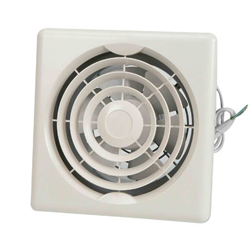Exhaust ventilation fans are used in homes, office spaces, factories and other types of buildings to remove humid or stale air from the area. Smaller fans are made of plastic with some metal parts, while industrial types are made mostly of aluminum. If you’re shopping around for a unit for your home, you should learn proper sizing for bathrooms or kitchens, and other frequently asked questions about exhaust ventilation fans.
The Home Ventilating Institute uses the ACH (air changes per hour) unit of measurement to categorize the number of times the air should be changed every hour. Each location such as the kitchen, bathroom or other room to be ventilated has a corresponding ACH for an exhaust fan to work effectively. For example, the HVI recommends a 6 ACH for normal rooms like bedrooms or home offices, while bathrooms need 8 ACH and kitchens 15 ACH. Of course, these measurements may still vary depending on the size of each area.
To identify the size of exhaust fan you need, you need to decide which part of the house needs ventilation and check the CFM rating (Cubic Feet per Minute) of fans.
The recommended CFM rating for every 10,000 BTU of your range is at least 100 CFM. As such, if you have a range with a 40,000 BTU rating, you can choose an exhaust fan with at least 400 CFM.
Back to Top
Best Location to Install an Exhaust Fan
Areas that are prone to moisture (such as the kitchen or bathroom) and rooms that are prone to humidity (like attics and basements) often require ventilation. Each situation is unique, so there is no one perfect location to install exhaust fans. However, an important consideration about exhaust ventilation fans is the proper sizing for the area you want it installed.The Home Ventilating Institute uses the ACH (air changes per hour) unit of measurement to categorize the number of times the air should be changed every hour. Each location such as the kitchen, bathroom or other room to be ventilated has a corresponding ACH for an exhaust fan to work effectively. For example, the HVI recommends a 6 ACH for normal rooms like bedrooms or home offices, while bathrooms need 8 ACH and kitchens 15 ACH. Of course, these measurements may still vary depending on the size of each area.
About Exhaust Ventilation FansCFM Rating and Sizing
Not all exhaust fans are made alike. Since each bathroom, kitchen or room has different sizes and fixtures that affect moisture or pollutant levels, the size of exhaust fan for each room varies greatly.To identify the size of exhaust fan you need, you need to decide which part of the house needs ventilation and check the CFM rating (Cubic Feet per Minute) of fans.
How to Choose Bathroom Exhaust Fans
Questions about exhaust ventilation fans for the bathroom can become complicated because there are several ways to compute for the CFM rating. Here is a straightforward way to do it:- Measure the bathroom’s height, length and width.
- Multiply all 3 measurements to determine air volume in the bathroom. For example, a bathroom that is 8x10x8 would have 640 cubic feet of air volume. This means that an exhaust fan must be able to ventilate 640 cubic feet of air in one ACH.
- Use the recommended ACH for bathrooms as stated above and multiply it with the air volume. In our example, 640 x 8 cubic feet = 5,120.
- Divide by 60 minutes to determine the recommended CFM rating of exhaust fan that could ventilate your bathroom efficiently. This case, divide 5,120 by 60, which gives you the CFM rating of 85.33 CFM.
- Now you still need to add CFM rating of different fixtures in your bathroom, such as bathtub (50 CFM), toilet (50 CFM), shower (50 CFM) or a whirlpool-type tub (100 CFM). If you only have a toilet and shower, add 100 CFM to 85.33 CFM and you get 185.33 CFM.
- Look for an exhaust fan with 185.33 CFM rating.
How to Choose Kitchen Exhaust Ventilation Fans
When talking about exhaust ventilation fans for the kitchen, you need to identify the BTU of your kitchen’s cooking range. BTU is the measurement of heat created by burning any material.The recommended CFM rating for every 10,000 BTU of your range is at least 100 CFM. As such, if you have a range with a 40,000 BTU rating, you can choose an exhaust fan with at least 400 CFM.
Back to Top
Exhaust Ventilation Fans

Exhaust Ventilation Fans Resources
Sponsored Links
